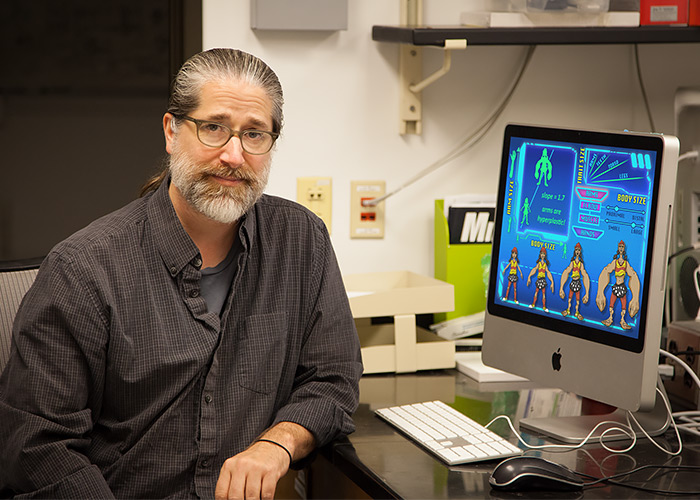Will Study How Natural Selection Produces Morphological Diversity in Species
The Vitruvian Man – the famous sketch by artist Leonardo Da Vinci – portrays a man standing inside an overlaid circle and square. His outstretched arms touch the opposite sides of the square while his head and feet touch the square's top and bottom.
 The Vitruvian man was Da Vinci’s illustration of the fact that humans, short and tall
alike, are proportioned similarly. Regardless of our size, our height equals the distance
from fingertip to fingertip. How trait size scales with body size is central to the
expression and evolution of animal form.
The Vitruvian man was Da Vinci’s illustration of the fact that humans, short and tall
alike, are proportioned similarly. Regardless of our size, our height equals the distance
from fingertip to fingertip. How trait size scales with body size is central to the
expression and evolution of animal form.
Tony Frankino, associate professor of biology and biochemistry in the College of Natural Sciences and Mathematics at the University of Houston, studies how natural selection can drive the evolution of body proportions. In support of this research, he was recently awarded a three-year, $435,000 grant from the National Science Foundation. These funds are part of an $835,000 collaborative NSF grant with Alex Shingleton, associate professor of biology at Lake Forest College.
Most Diversity in Species Due to Differences in Trait Proportions
“Most of the morphological diversity we see among species or other biological groups is not due to unique or novel traits. Instead, it results from changes in the size of one trait relative to another,” Frankino said. “This effect can also be seen in comic-book monsters and superheroes, who differ primarily in their body proportions.”
For example, when comic-book hero Dr. Bruce Banner transforms into his alter-ego the Hulk, his torso swells, his arms thicken and grow longer, but his head remains roughly the same size. The result is a Hulk that looks very different from Bruce Banner because of changes in the typical proportions of the human form.
Similar to the Hulk’s transformation, changes in body proportions produce morphological diversity among species that share the same basic body architecture. For example, penguins and flamingos are made of the same parts, but look different because the relative sizes of their necks, legs and other bits are so divergent.
How Species Evolve Different Proportions
“Most morphological traits scale proportionally with each other and with body size such that larger adults are essentially uniformly magnified versions of smaller ones. For example, even though people differ in height, our arms and legs are always correctly proportioned for our torsos,” Frankino said.
Biologists such as Charles Darwin, Julian Huxley and Stephen J. Gould all studied the relationship between body proportion and morphological diversity. But what scientists still don’t really understand is how proportions are maintained within species, or how evolution changes proportions to produce morphological diversity among species. Elk antlers represent one such change in trait proportion - as the body size of an elk increases, its antlers grow disproportionately, producing greatly oversized antlers in large individuals.
Currently, Frankino’s research is focused on the effects that nutrition and genetics have on determining the size of morphological traits, the body, and the relationship between the two, which he believes will reveal how evolution produces changes in body proportions. In this case, evolution changes body proportions through natural selection - the process by which change within and among species occurs by favoring individuals that are best suited to survive and reproduce in their environment.
Body Size Determined By Both Nutrition and Genetics
Body size is determined both by genetics and the nutritional environment; a well-fed individual will grow to be bigger than an identical individual who was underfed. But even with perfect nutrition, genetics determines the limit to how big an individual will grow. On the converse side, individuals that are small because of poor nutrition may have genetics that could, with proper nutrition, give them a really big body size or simply an average body size. In this way, nutritional and genetic effects combine to determine the size of all morphological traits, and consequently, their sizes relative to one another or the body.
Genetic Variation in Body Size Thought to Determine Response to Selection
“What no one has thought about is the role of the genetic variation that underlies an individual’s relative trait sizes and how that affects evolutionary outcomes,” Frankino said. “The patterns of individual genetic variation in relative trait and body sizes are most likely affecting what the response to natural selection will be.”
Effects of nutrition on trait and body size are determined primarily by the insulin signaling pathway. Frankino’s research will focus on identifying patterns of genetic variation in the insulin signaling pathway in fruit flies. Using this information, he wants to determine how this variation may affect the possible responses to natural selection.
‘Monster Me’ Computer Game Will Teach Allometry Concepts to High School Students
In addition to funding Frankino’s research, this grant also supports the creation of a computer game, called Monster-Me, that will teach high school students how morphological diversity relates to scaling. Similar to Bruce Banner’s transformation into the Hulk, high school students will be able to use photos of themselves to alter their body proportions, creating ‘monster and superhero’ versions of themselves. This portion of the project will be developed in collaboration with Jose Baez-Franceschi, an assistant professor in UH’s College of Technology.
- Rachel Fairbank, College of Natural Sciences and Mathematics